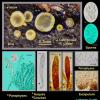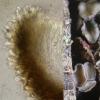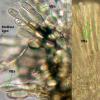
14-01-2026 10:02
Hulda Caroline HolteHello, These ascomycetes were growing on standing

13-01-2026 10:13
 Danny Newman
Danny Newman
Cordieritidaceae sp. on indet. wood w/ Hypoxylon s

13-01-2026 07:57
 Danny Newman
Danny Newman
cf. Bombardia on indet. decorticate woodAppalachia

14-01-2026 07:28
 Danny Newman
Danny Newman
Nemania sp. on indet. decorticate woodAppalachian

12-01-2026 22:02
Ethan CrensonHello all, I am hoping someone will have some ins

11-01-2026 20:35
Hello.A very tiny pyrenomycete sprouting sparsely

13-01-2026 18:55
Rees CronceStrossmayeria sp. on indet. decroticate hardwoodTh

13-01-2026 07:28
 Danny Newman
Danny Newman
Chlorociboria glauca on indet. decorticate logThe

13-01-2026 07:14
 Danny Newman
Danny Newman
Neodasyscypha cerina on indet decorticate logThe S

13-01-2026 09:10
 Danny Newman
Danny Newman
Dasyscyphella chrysotexta on indet. decorticate ha
Mollisia caespiticia ?
Roland Labbé,
01-03-2009 02:23
Encore besoin d'aide pour ce Disco jaune ochracé.
Merci de vos réponses.
Roland
Détails :
Date de récolte: 2009 / 02 / 24
Substrat : culture intérieure sur bûche en décomposition d'érable rouge
Sporée non obtenue
Asques à 8 spores bisériées, avec crochet à la base, avec appareil apical inamyloïde, 48-50 x 5 -6 µm
Paraphyses cylindriques, à 1 ou 2 septa au tiers inférieur, avec vacuoles hyalines allongées ?, 50 x 2-3 µm, dépassant à peine les asques
Spores étroitement ellipsoïdes, lisses, non septées ? ou à un septum médian très mince et hyalin difficile à préciser et rarement observé, hyalines, avec 2-3 guttules, 5-7 x 2-3 µm, 5,9 x 2,5 µm en moyenne (10 spores), Q = 2,36
Excipulum en textura globulosa
Hans-Otto Baral,
01-03-2009 10:12

Re:Disco jaune ochracé
The excipulum looks like in Mollisia. M. caespiticia would be one of the very few lignicolous species of Mollisia with inamyloid asci. To verify it would be valuable to see living paraphyses. Only the spores are alive on your oil immersion photos. If the living paraphyses contain a reftactive elongate vacuole (typical of every true Mollisia) then I would identify M. caespiticia. Perhaps a median section of the apothecia (especially marginal region) would be helpful too.
I have only somewhat atypical images from a Mongolian collection, but the species is not rare in Central Europe.
Zotto
I have only somewhat atypical images from a Mongolian collection, but the species is not rare in Central Europe.
Zotto
Roland Labbé,
03-03-2009 01:27
Re:Mollisia caespiticia
Hi Zotto !
I have changed the plate and added inamyloïde ascus and lived paraphyses (yong specimens).
I think there are elongated hyaline vacuoles in the paraphyses as you daid.
This question : what do you mean by the excipulum looks like in Mollisia or what is the structure of a true Mollisia ?
I hope it'is all right.
Roland
I have changed the plate and added inamyloïde ascus and lived paraphyses (yong specimens).
I think there are elongated hyaline vacuoles in the paraphyses as you daid.
This question : what do you mean by the excipulum looks like in Mollisia or what is the structure of a true Mollisia ?
I hope it'is all right.
Roland
Hans-Otto Baral,
03-03-2009 15:57

Re:Mollisia caespiticia ?
Hi Roland
I cannot see a difference in your image to what I remember, the paraphyses on the left are still dead, those on the right too minute to be sure. Could you extract them in higher resolution, please? . Here I have an image of the close Mollisia ligni showing the VBs in marginal hairs and paraphyses. Similar VBs exist in M. caespiticia and in all true Mollisias. Without these VBs I am somewhat unsure with my determination of the genus.
Zotto
I cannot see a difference in your image to what I remember, the paraphyses on the left are still dead, those on the right too minute to be sure. Could you extract them in higher resolution, please? . Here I have an image of the close Mollisia ligni showing the VBs in marginal hairs and paraphyses. Similar VBs exist in M. caespiticia and in all true Mollisias. Without these VBs I am somewhat unsure with my determination of the genus.
Zotto


